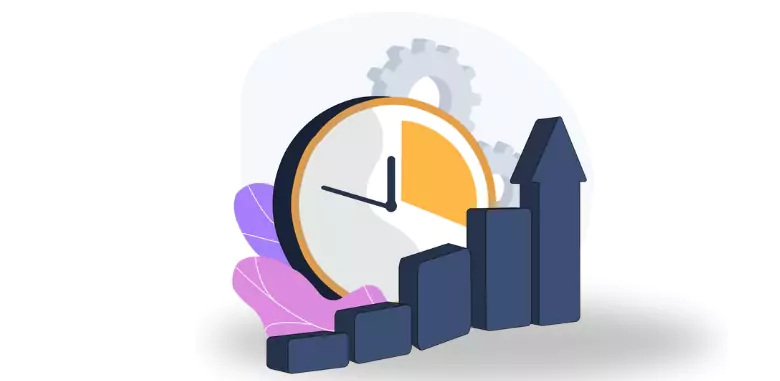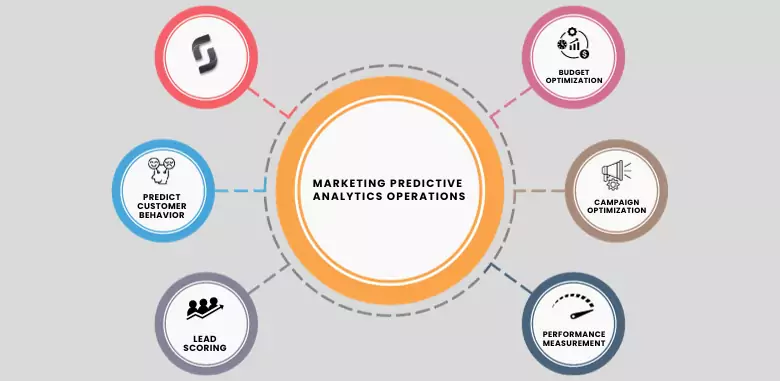
The area of Marketing Predictive Analytics is gaining popularity in many domains. It is all about making smart decisions using data analysis and statistical methods to forecast future marketing results. In this blog, we will discuss, with the help of clear and practical examples, how predictive analytics can be used in marketing. So, let’s dive in:
Predict Customer Behavior:
Predictive analytics helps marketers predict how customers are likely to behave in the future. This includes predicting which products or services they are more likely to purchase, how they will respond to marketing campaigns, and whether they are at risk of churning (leaving the brand).
For example, in the retail industry, if historical data analysis shows that customers who purchase hiking boots are likely to buy camping equipment within the next month, a company can target these customers with camping gear promotions. This increases the likelihood of additional purchases, based on customer interest and improves the overall shopping experience.
Segment Customers:
It enables the creation of more precise customer segments. It does not rely solely on demographics. It uses a wide range of data, such as past purchase history, online behavior, and engagement metrics, to segment customers based on their predicted behavior and preferences.
Consider an online streaming service aiming to enhance user experiences. Rather than relying solely on age or location, they turn to predictive analytics. It uncovers an insight: users who frequently stream comedy shows also tend to explore documentary series.
With this insight, they introduce a segment called “Explorers of Comedy and Knowledge.” Subscribers in this category receive personalized recommendations, including a mix of hilarious comedies and thought-provoking documentaries. The result? Increased viewer satisfaction, longer subscription durations, and a reputation for understanding their audience on a deeper level. Predictive analytics showcases its ability to shape segments based on anticipated behaviors and preferences, breaking free from conventional demographic constraints.
Read this article to know in depth about how to use Generative AI for Marketing.
Lead Scoring:
Marketers use predictive models to assign scores to leads or prospects based on their likelihood to convert into customers. This helps sales and marketing teams prioritize their efforts and focus on leads that are most likely to result in sales.
Imagine a car dealership getting inquiries from people wanting to buy a car. Not all inquiries are the same. Some people are really ready to buy, while others are just looking around.
In a busy car dealership, predictive lead scoring is like a smart helper. It watches how people act on the website. If someone spends lots of time checking out sports cars and comes back often, they get a high score. It means they’re really interested. But if someone just looks at one car quickly, they get a lower score. It doesn’t mean they forget about them, but they know they might need more time.
When people send messages asking about cars, they pay attention to how serious they are. If someone asks lots of questions and sounds like they want to buy, they get a higher score. But if the message is vague, they might get a lower score because they’re not sure if they’re ready to buy.
If someone has bought a car there before, they also get a higher score. They like to take care of their repeat customers. And if they reply to messages quickly, it shows they care about helping. So, if someone with a high score asks a question, they make sure to reply fast.
Also, they listen to what other customers say. If they liked their service and told their friends, it’s a good sign. They use all these scores to help them talk to customers in the best way. If someone is super interested, they give them extra attention. But for others, they’re patient and keep in touch until they’re ready to decide. Predictive lead scoring helps them do this just right!
Personalization:
Predictive analytics allows for highly personalized marketing efforts. By analyzing individual customer data and behavior, marketers can deliver tailored messages, product recommendations, and offers. Personalization enhances customer engagement and conversion rates.
Imagine you’re a regular customer of an online fashion store. This store uses predictive marketing analytics to take your shopping experience up a notch.
Here’s how it works: Every time you visit the website, the predictive analytics system remembers your preferences. It analyzes your past shopping behavior and notices that you often browse for sneakers and denim jackets.
Using this data, the system predicts what you might like next. So, the next time you log in, it not only showcases the latest sneaker arrivals and trendy denim jackets but also suggests complementary items like stylish t-shirts and accessories based on your predicted preferences. Furthermore, it sends you personalized emails with discounts on those recommended items or similar ones, all backed by predictive marketing analytics. This personalization makes your shopping experience feel like it’s curated just for you, increasing your interest and the likelihood of making a purchase. Predictive marketing analytics, in this scenario, helps create a tailored shopping experience by analyzing your past behavior and anticipating your future preferences.
Churn Prediction:
Predictive analytics can identify customers who are at risk of churning (canceling subscriptions or leaving a service). Businesses can use this insight to take proactive measures to retain customers through targeted retention strategies.
Consider using a fitness app to keep track of your health and workouts. This app uses something called predictive analytics to help you stay motivated and keep using it. It looks at what you do, like your workouts and what you eat. If it sees you slowing down, it sends you messages with workout ideas that match what you like to keep you excited about staying healthy.
To make sure you keep using the app, it gives you fun challenges to complete. These challenges are made just for you, so they’re not too hard. When you finish them, you get cool rewards like badges or discounts on workout gear. These rewards make you want to keep going.
The app also has a place where you can talk to others who use it. You can share your progress and tips with them. This makes you feel like you’re part of a group that cares about fitness and motivates you to stay active and healthy. Predictive analytics helps the app understand when you might lose interest and gives you the right nudge to keep going. It’s like having a friendly fitness coach who knows exactly what you need to stay on track!
If you want to read more about churn prediction, check out an Empirical Study on Customer Churn Behaviours Prediction.

Budget Optimization:
It helps optimize marketing budgets by forecasting the expected outcomes of different marketing strategies and channels. This ensures that resources are allocated to campaigns and channels that yield the highest return on investment (ROI).
Consider an e-commerce company that sells a variety of products online. They’re looking to make the most of their marketing budget by predicting which advertising channels will yield the highest return on investment (ROI).
Using marketing predictive analytics, they analyze historical data and discover a pattern: during holiday seasons, their social media ads perform exceptionally well, generating significant sales. However, during non-holiday periods, email marketing campaigns tend to have the best ROI.
Using this insight, they adjust their marketing budget allocation. As the holiday season approaches, they allocate more funds to social media advertising, ensuring they capture the seasonal shopping spree. During other times, they shift resources toward email marketing, which consistently delivers strong ROI.
This dynamic budget optimization strategy, driven by marketing predictive analytics, ensures that resources are channeled where they are most effective. It maximizes the ROI on their marketing spending, helping the company achieve better results while maintaining budget efficiency. In this way, marketing predictive analytics plays a key role in strategic resource allocation for optimal marketing outcomes.
Learn more about Data-Driven Decision Making with Business Analytics for SMEs in our dedicated blog.
Campaign Optimization:
Marketers can use predictive analytics to refine and optimize marketing campaigns in real time. By continuously monitoring campaign performance and adjusting strategies based on predictive insights, businesses can maximize their campaign effectiveness.
Consider the world of online advertising to understand how marketing predictive analytics can optimize marketing campaigns in real-time. Imagine an e-commerce retailer running a digital advertising campaign to promote a new product line.
Using marketing predictive analytics, they monitor the campaign’s performance as it unfolds. Early on, the data shows that a specific ad creative with vibrant visuals and an upbeat tone is resonating well with their target audience. Additionally, predictive analytics indicates that this ad is likely to perform even better in the coming days.
In response, the marketing team decided to allocate more of their budget to the high-performing ad. They also adjust the campaign schedule to increase its visibility during peak engagement hours. As a result, the campaign’s click-through rates and conversion rates soar.
Simultaneously, predictive analytics identifies another ad variant that isn’t gaining traction and is unlikely to improve significantly. The team decided to reallocate the budget originally assigned to this ad to further boost the successful one.
By continuously monitoring and optimizing their campaign in real-time based on predictive insights, the retailer maximizes the effectiveness of their marketing efforts. They achieve better results, higher engagement, and increased sales—all thanks to the strategic use of marketing predictive analytics to fine-tune their campaigns on the fly. This example illustrates how marketing predictive analytics can be a powerful tool for dynamic campaign optimization.
Performance Measurement:
Predictive analytics also plays a role in measuring the success of marketing efforts. Marketers can use predictive models to set performance benchmarks and assess how well they meet their objectives.
Consider a digital marketing agency tasked with promoting a new mobile app. They want to measure the success of their marketing efforts and ensure they’re meeting their objectives.
Using marketing predictive analytics, they create a predictive model that anticipates the app’s expected download numbers based on various marketing activities, such as online ads, social media campaigns, and influencer partnerships. The model also factors in external variables like market trends and competitor activities.
At the beginning of their campaign, the predictive model sets a benchmark—let’s say they aim for 100,000 app downloads within the first month. As the campaign progresses, they continuously input real-time data into the model to assess performance.
Midway through the campaign, the model predicts they’re on track to achieve 80,000 downloads by the end of the month. Recognizing the need to boost performance, they decided to allocate an additional budget to social media advertising, which the model suggests has the potential to drive more downloads.
By the end of the month, they surpassed their initial benchmark and achieved 110,000 downloads, thanks to their data-driven adjustments. This demonstrates how marketing predictive analytics not only sets performance benchmarks but also enables marketers to assess their progress in real time, make informed adjustments, and ultimately achieve or exceed their objectives. In this example, marketing predictive analytics aids in both planning and evaluating marketing success. For more details read HubSpot which provides a comprehensive guide to predictive analytics in marketing.

Conclusion:
Marketing Predictive Analytics empowers businesses to know and predict customer behavior, create personalized experiences, and optimize their strategies for success. Using data and smart algorithms, not only boosts marketing effectiveness but also ensures that resources are used efficiently.
This powerful tool is here to stay, shaping the future of marketing. It guides businesses toward smarter decisions, happier customers, and better results. As technology advances, Marketing Predictive Analytics will continue to evolve, making marketing more data-driven, personalized, and successful than ever before. Explore how Predictive Analytics is also transforming Human Resources in our related blog on HR Predictive Analytics.
Author
Team Solutyics is a dynamic group of Analytics and AI specialists who bring together a rich mix of expertise. Their combined insights ensure that readers gain a deeper understanding of practical applications of Analytics and AI.
